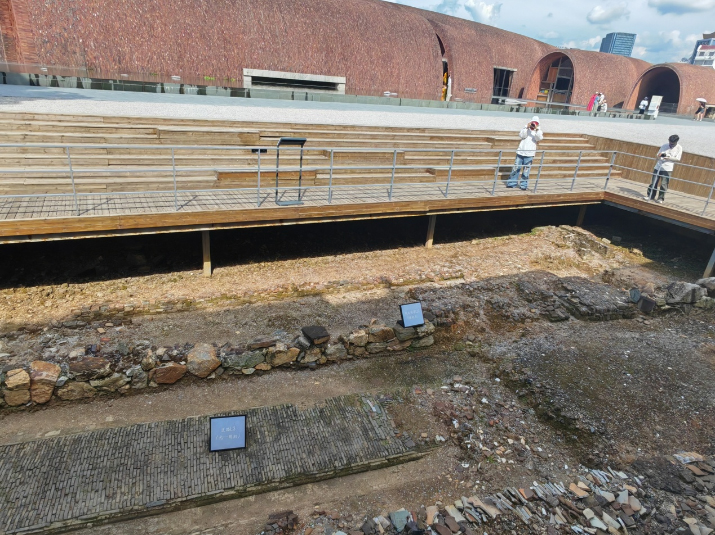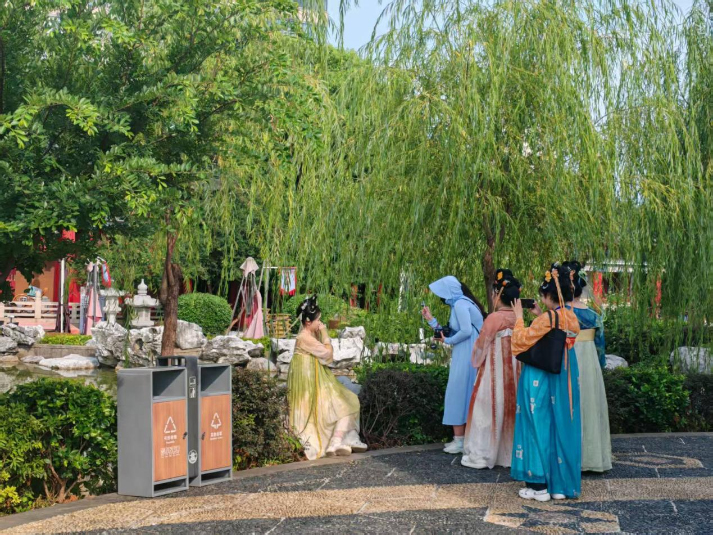| China |
| The renewal and preservation of cultural landmarks in the process of urbanization | |
|
|
 The preserved site of Ming Dynasty (1368-1644) ruins across the Imperial Kiln Museum in Jingdezhen, Jiangxi Province, on July 13 (ZHANG YAGE)
Tang Dynasty poet Wang Bo (650-676) immortalized the Tengwang Pavilion in Nanchang, Jiangxi Province, with his legendary lines: "Sunset clouds float with a lone duck in flight. The autumn river blends with the vast sky in one hue." This poetic masterpiece not only stands as an eternal gem in Chinese literary history but also propelled this landmark to worldwide fame. The pavilion is revered as one of the "Three Great Towers of South China." Originally constructed in 653 during the Tang Dynasty (618-907), it was commissioned by Li Yuanying, also known as Prince Teng, hence its regal name. Over its 1,300-year history, the pavilion has endured rounds of destruction and reconstruction, with records indicating 28 major renovations. The latest restoration, completed in 1989, faithfully revived its ancient grandeur. The pavilion served as an exclusive leisure destination for scholars and nobility in imperial China, while after the reconstruction in modern China, it became a ticketed scenic area secluded from the public city sphere. But since early 2025, Nanchang's Three Returns and Northern Expansion urban renewal initiative has rewritten this narrative. By expanding and opening up part of the historic site, the local government has converted the millennium-old landmark into what residents proudly call their "urban backyard"—a cultural oasis now freely accessible to all. "I'm currently at the Tengwang Pavilion, where I can get a clear view of the structure," Nanchang resident Zhu Yue told Beijing Review. "Every week, my family and I go for a walk here. We'll walk along the riverside during off-peak visiting times. This has enhanced our passion for our landmark building and provided extra entertainment facilities."  A hanfu (the traditional attire of the Han Chinese) travel shoot is in full swing in the free-access area of the Tengwang Pavilion Scenic Area in Nanchang, Jiangxi, on July 8 (ZHANG YAGE)
Shared results In 2024, Nanchang launched the ambitious Three Returns and Northern Expansion project at the Tengwang Pavilion, transforming the historic site into a lively public space. The "Three Returns"—returning the river, shoreline and scenery to the people—expanded the previously ticketed area, opening new sections to all visitors free of charge. The "Northern Expansion" provided a shortcut from the pavilion area to Dashiyuan, a local historic community, and the Wanshou Palace commercial hub, allowing tourists to enjoy one-stop heritage exploration, while locals gain a revitalized waterfront leisure zone and more conveniences in entertainment, transportation and consumption. "The Tengwang Pavilion sits along the Ganjiang River and near Poyang Lake. In the past, the ticketed area and adjacent docks partially blocked public access to the riverfront," Li Songdian, Director of the Publicity Department of the Communist Party of China Nanchang Municipal Committee, said. "The newly expanded waterfront zone, with its riverside promenades and traditional architecture, is open to all. Many locals come here to take a stroll, enjoy the evening breeze and admire the illuminated river views after dark." Completed on January 1, this project removed 600 meters of solid walls, expanding the scenic area to approximately 280 hectares, with 90 percent of the zone now open to the public free of charge. Since most of the scenic area's opening up to the public, foot traffic in surrounding commercial districts, including Wanshou and Dashiyuan, has surged by 210 percent year on year. During this year's Spring Festival holiday, from January 29 to February 12, 80 percent of the 1.06 million visitors to the pavilion gathered in the free-access areas. The project has also contributed to the attraction's revenue growth. According to statistics from Nanchang's cultural and tourism department, during this year's May Day holiday, on May 1-5, the structure received nearly 700,000 visitors. Among them, 125,700 entered paid sections—an 8.73-percent year-on-year rise—generating 4.49 million yuan ($460,000) in ticket revenue, up 10.65 percent from last year. Meanwhile, the free-access areas welcomed 568,300 visitors, with newly opened businesses, including snack stalls, gift shops, and hanfu (the traditional attire of the Han Chinese) experience stores, benefiting from the surge in foot traffic. Zhu Xu, Chairman of Jiangxi Nanchang Tourism Group Co. Ltd. and head of the project, explained that one of the key indicators of urban development lies in the improvement of residents' quality of life. "The expansion of the Tengwang Pavilion Scenic Area has not only created more recreational space for both tourists and local residents, but also allows them to experience the profound cultural heritage up close while enjoying the conveniences of modern city life. The combination of historical immersion and modern accessibility has been the driving force behind the scenic area's increase in visitor numbers following its expansion," Zhu explained. Preservation in process One of urban renewal's greatest challenges lies in preserving historical architecture while enabling modern development. Taoyangli Historic Cultural District in Jingdezhen presents an innovative solution. Situated in the heart of the city, this district weaves together layers of ceramic history: 108 ancient alleyways dating back 1,000 years, the 650-year-old Imperial Kiln Factory (now a protected heritage site), 400-year-old kiln workshops from the Ming and Qing dynasties (1368-1911), and the 70-year-old Porcelain Factory. For over 1,700 years, Jingdezhen has been the heart of China's ceramic artistry, earning its title as the nation's "Porcelain Capital." Renowned for its exquisite blue-and-white ware and imperial kilns that supplied the Ming and Qing courts, this UNESCO Creative City blends ancient craftsmanship with modern innovation. In today's Taoyangli, adjacent to the former grounds of the imperial kilns and porcelain factories, stands the Imperial Kiln Museum complex—an energetic hub featuring ceramic markets, artisan exhibition spaces and protected heritage sites. The adjacent alleyway district, once home to ceramic workers, has preserved its original architectural structures while transforming into a cultural-commerce quarter. This refreshed area now hosts 202 businesses offering immersive experiences ranging from craft workshops and educational tourism to leisure shopping and boutique hospitality. "Our fundamental philosophy in designing and constructing this district has been preservation and restoration—preserving the ceramic culture embodied in this area and restoring traces of how people lived here in the past," Liu Zili, former Chairman and General Manager of Jingdezhen Ceramic Culture Tourism Development Group, said. "We've maintained strict authenticity in conserving historical structures, using original building materials wherever possible in our renovations. The complete spatial layout has been retained, including the front and back street pattern, the traditional structure of the kiln and clay workshop, and residential housings." "For example, about 30 percent of the bricks used to construct the Imperial Kiln Museum came from the site of old resident's discarded housings, lending this modern building a sense of history," Liu said. "And right across the museum, the excavated Ming ruins have been given protective barriers. This blend of modernity and history is very attractive for tourists." "In Taoyangli, we bridge ancient heritage with cutting-edge technology," Hua Jing, Director of Taoyangli Scenic Area, which includes Taoyangli Historic Cultural District, said. "Visitors can use virtual reality and augmented reality to travel back in history—visiting sites from ancient city walls to kiln sites that evoke cultural memory. With over 4,000 annual events last year, including night tours, temple fairs and ceramic markets, we have created a host of immersive experiences for our visitors. Last year's visitor traffic reached 5.22 million." He added, "We also made efforts to protect ceramic intangible cultural heritage by boosting online sales via social media promotions on both domestic and overseas platforms." (Reporting from Jingdezhen, Jiangxi Province) Copyedited by Elsbeth van Paridon Comments to zhangyage@cicgamericas.com |
|
||||||||||||||||||||||||||||
|